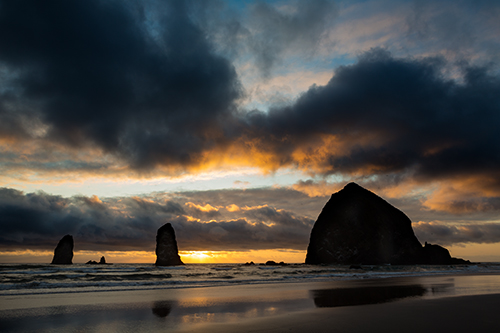Recently I was on the Oregon Coast, hoping to photograph some great skies over the ocean. On most of my trips to the coast I have encountered a great deal of fog, which is interesting, but I was looking for something different. Several evenings looked very promising, and then at the last minute fizzled out. On this particular evening, we had a wonderful sunset, for about 2 minutes, and then the sun dropped below the marine layer and all of the color disappeared. I worked hard and fast to position myself to capture this scene, and it made the entire trip worthwhile!
As is so often the case, the light changed so rapidly that I was very thankful to understand the technical side of photography. If I had been relying on the camera to make all of my decisions, I highly doubt that I would have been successful here. With such a high contrast scene, maintaining detail in both shadows and highlights and keeping good saturation in the color is not an easy task. Some would say to shoot several exposures and layer them, or shoot for HDR. Why, when it can be done, in my opinion, better in a single image? I have been and always will be a fan of getting it right in camera. It makes the printing process so much simpler and usually cleaner and sharper.
To really understand photography to the point of creating what my minds eye sees, and doing so almost without thinking has taken a lot of study, practice, mistakes, evaluation, more mistakes, and on and on. All of that time and effort has paid off for me many times over. One of the hardest things to convince my students of is that it is OK to make mistakes. That is how we learn. I still, after 30 plus years of practice, make mistakes. The difference, though, is that I evaluate them and learn from them. They make be better!



your pictures rock